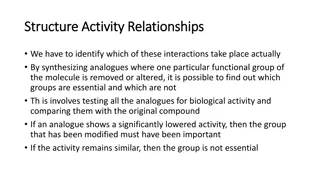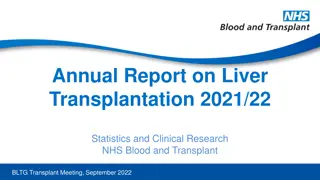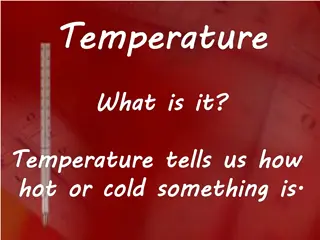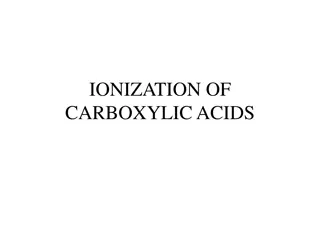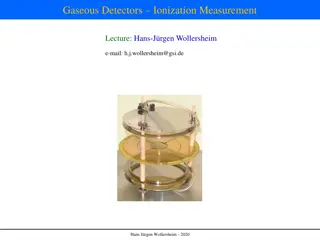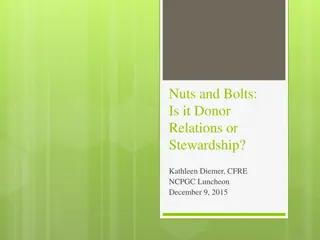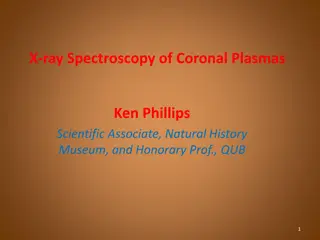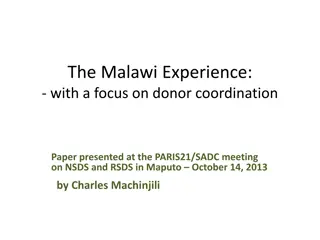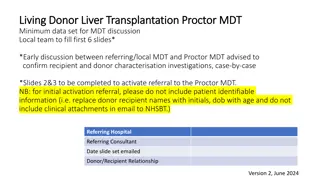Understanding Temperature Effects on Donor and Acceptor Ionization in Semiconductors
Temperature plays a crucial role in the ionization of donor and acceptor atoms in semiconductors. In N-type semiconductors, the Fermi level lies below the conduction band, while in P-type semiconductors it lies above the valence band, with the position depending on temperature and impurity atoms. Donor atoms with extra electrons easily ionize when temperature increases, contributing to electron concentration. Different elements like phosphorus, arsenic, and antimony are used as donors in silicon. The temperature ratio between majority carrier concentration and doping concentration influences ionization levels. At room temperature, all donors are assumed to be ionized, impacting carrier concentration.
Download Presentation

Please find below an Image/Link to download the presentation.
The content on the website is provided AS IS for your information and personal use only. It may not be sold, licensed, or shared on other websites without obtaining consent from the author. Download presentation by click this link. If you encounter any issues during the download, it is possible that the publisher has removed the file from their server.
E N D
Presentation Transcript
LECTURE 4 Temperature affect on donor and acceptor ionization 1
Recap In N-type semiconductor the Fermi-level lies below the bottom of the conduction band. In P-type Semiconductor the Fermi level lies above the top of the valence band. The position of Fermi level in both cases depends upon the temperature and then number of impurity atoms. At very high temperatures the Fermi level approaches the middle of forbidden energy gap, hence behave like Intrinsic semiconductor in both N and P type semiconductors. 2
Donor and acceptor ionization? A donor is an element with typically one more valence electron than the element that forms the semiconductor. An acceptor is an element with typically one fewer valence electron than the element that forms the semiconductor. An ion is an electrically charged atom or group of atoms. Ionization occurs when an electron is removed from or added to an atom, in this case it would be the dopant atoms. The donor's extra electron is weakly bound and needs very little energy, thermal or otherwise, to break the bond and become a free electron. As temperature is increased, more and more of these bonds are broken, until all the donors are ionized, producing an increase in electron concentration. At room temperature, we assume all the donors are ionized. 3
Donar Ionization For silicon, we can use phosphorus (P), arsenic (As) or antimony (Sb) as donors. These are column V elements, with five electrons in their outermost shell. When these atoms are included in the silicon crystal, one of the electrons in this shell can easily jump to the conduction band, leaving a positively charged atom behind. This process is sometimes called activation or ionization of the donor atoms. The positively charged donor atom that is left behind after ionization is immobile and does not contribute to conduction. The electron leaving the atom by ionization does, and is counted in the electron concentration n. Because the activation energy is low, at room temperature almost all of the donor atoms included in the crystal will give an electron to the conduction band. 4
Donar Ionization Temperature Ratio between the majority carrier concentration and the doping concentration n/ND 0K n/ND = 0 n/ND < 1 n/ND = 1 n/ND > 1 150k 300K Above than 500K At 0 K the electrons at the donor sites do not receive enough energy to make it to the conduction band, so the ratio between the majority carrier concentration and the doping concentration n/ND = 0. As the temperature is increased , more donor electrons make it to the conduction band, but at temperatures below 150 K all the donor sites have not been ionized so the ratio n/ND < 1 and the majority carrier concentration is made up of the donor electrons that have made it to the conduction band. 5
Donar Ionization At room temperature, we assume all the donors are ionized, meaning all donor electrons are in the conduction band, so the ratio n/ND = 1 and the majority carrier concentration is made up of the donor electrons. At very high temperatures, above 500 K, electrons from the valence band receive enough energy to make it to the conduction band and out number the electrons from the donor sites, so the ratio n/ND > 1 and the majority carrier concentration is now made up of electrons from the valence band in the conduction band, as in an intrinsic semiconductor. 6
Acceptor Ionization For silicon, we can use boron (B), Aluminum (Al) and Gallium (Ga) as acceptors. These are column III elements, with three electrons in their outermost shell. When these atoms are included in the silicon crystal, one of the electrons in the silicon valence band can easily jump to the valence shell of one of the acceptor atoms, leaving a hole behind and making the acceptor atom negatively charged. The negatively charged acceptor atom after an electron joins its valence shell is immobile and does not contribute to conduction. The hole left behind by that electron does, and is counted in the hole concentration p. Because the activation energy is low, at room temperature almost all of the acceptor atoms included in the crystal will accept an electron from the valence band. 7
Acceptor Ionization Acceptors have one fewer valence electron than the neighboring semiconductor atoms and will readily accept an electron in order to completely bond. Very little energy is needed for an electron to travel to one of the acceptor sites and be trapped. As the temperature is increased, more electrons become trapped in acceptor sites, until all the acceptors are ionized, causing the hole concentration to increase. At room temperature, we assume all the acceptors are ionized. Temperature Ratio between the majority carrier concentration and the doping concentration p/NA 0K p/NA = 0 p/NA < 1 p/NA = 1 p/NA> 1 150k 300K Above than 500K 8
Acceptor Ionization At 0 K the electrons in the valence band do not receive enough energy to jump to an acceptor site and create a hole, so the ratio p/NA = 0. At temperatures below 150 K the ratio p/NA < 1 because all the acceptor sites have not been ionized, so the majority carrier concentration is made up of the holes left behind by trapped electrons in the acceptor sites. At room temperature we assume all the acceptors have been ionized. The ratio p/NA = 1 because the majority carrier is made up of the holes created by the ionized acceptors. At very high temperatures, above 500 K, the ratio p/NA > 1 because the holes created by electrons from the valence band jumping to the conduction band out number the holes that had been created by acceptors, so the majority carrier concentration is made up of holes created by valence electrons in the conduction band, as in an intrinsic semiconductor. 9
The release of the electron by the impurity does NOT result in the generation of a hole. The impurity, called a donor, becomes ionised (positive charge) but is locked into the lattice and unable to move. Nonetheless, it can still effect the motion of electrons when an electric field is applied to the semiconductor and a current flows or the positively charged donor atom that is left behind after ionization is immobile and does not contribute to conduction. The electron leaving the atom by ionization does, and is counted in the electron concentration n. Also the release of the hole by the acceptor impurity does NOT result in the generation of an electron. Rather, the acceptor becomes ionised (negative charge) but is locked into the lattice and unable to move. It too can influence the motion of charge when an electric field is applied to the semiconductor and a current flows. Or the negatively charged acceptor atom after an electron joins its valence shell is immobile and does not contribute to conduction. The hole left behind by that electron does, and is counted in the hole concentration p. 10
Charge carrier concentration vs Temperature Extrinsic 11
At the other extreme of very low temperature ( larger 1/T ) , negligible electron hole pairs exists, and the donar electrons are bound to the donar atoms. This temperature region is called Freeze out region. As the temperature is raised , these electrons are donated to the conduction band and all the donar atoms are ionized . This temperature region is called Ionization region. Once the donar are ionized , the conduction band electron concentration is n0= Nd, since one electron is obtained for each donar atom. When every available extrinsic electron has been transferred to the CB, n0 is virtually constant with temperature until the concentration of intrinsic carriers ni becomes comparable to the extrinsic concentration Nd Finally, at high temperature n i is much greater than Nd and intrinsic carrier dominates. n = p = ni. In other words, the semiconductor becomes intrinsic at very high temperatures. 12
Summary The release of the electron by the impurity does NOT result in the generation of a hole. The impurity, called a donor, becomes ionised (positive charge) but is locked into the lattice and unable to move. Also the release of the hole by the acceptor impurity does not result in the generation of an electron. Rather, the acceptor becomes ionised (negative charge) but is locked into the lattice and unable to move. It too can influence the motion of charge At the other extreme of very low temperature the donar electrons are bound to the donar atoms. This temperature region is called Freeze out region. As the temperature is raised , these electrons are donated to the conduction band and all the donar atoms are ionized . This temperature region is called Ionization region. At very high temperatures extrinsic semiconductors become intrinsic. 13


